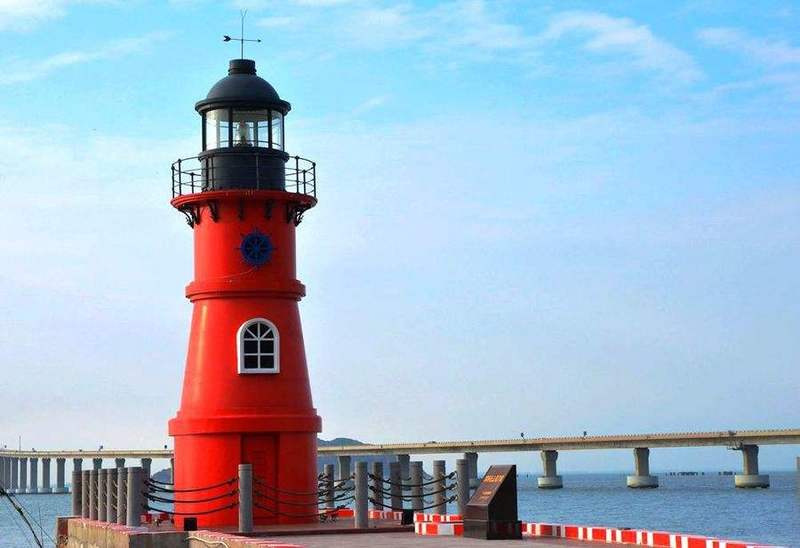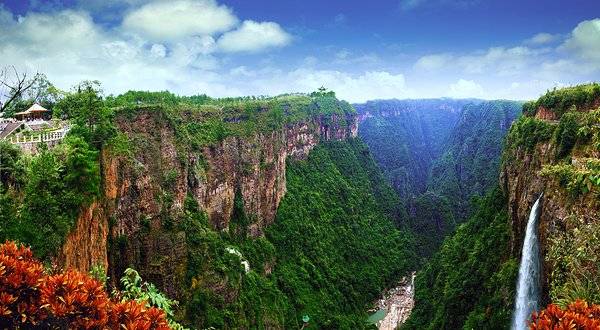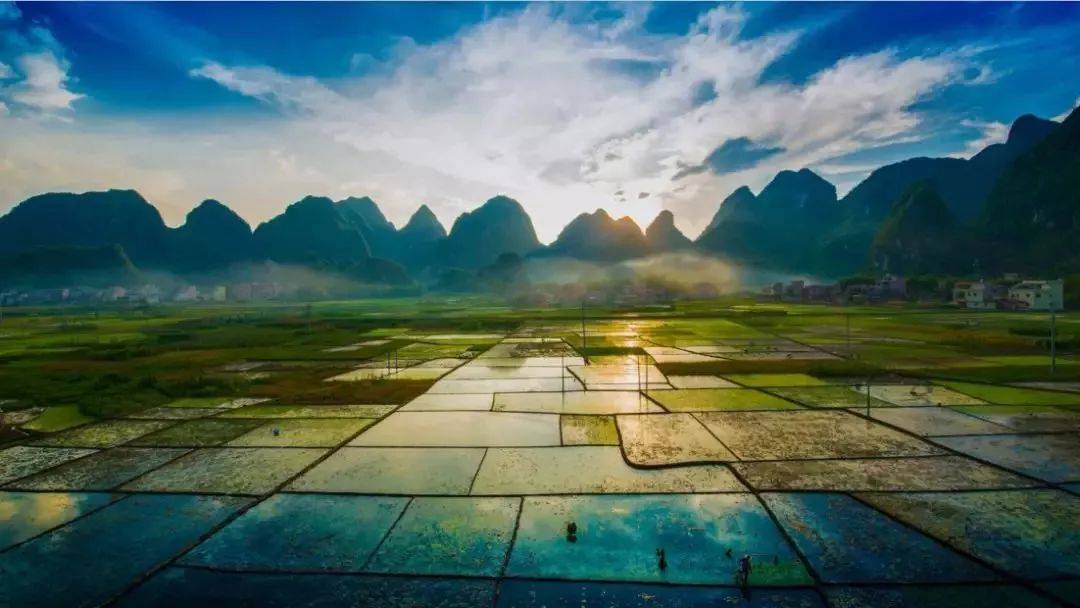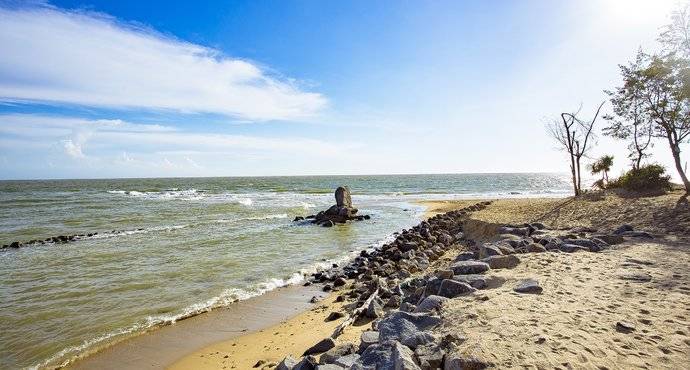Zhaoqing Dinghu Mountain
It is one of the four famous mountains in Lingnan, located in the northeast direction of Zhaoqing city. It enjoys the reputations of 'Oasis on the Tropic of Cancer', 'Natural Oxygen Bar', and 'Living Natural Museum'. It is the first choice for tourism, vacation, summer leisure, fitness, health, and scientific investigation. The rainy season of Dinghu Mountain is from June to August. During the rain, fog often rises in the mountains, and within 1-2 hours after the rain, walking in the primitive forest of Dinghu Mountain, with high mountains and flowing water, mist lingering, it feels like a dream. Beautiful landscape paintings unfold slowly under your feet. Imagine a family walking in the mountains, breathing in the fresh scent of mud and grass brought by the rain, feeling the pores of the entire skin open. Leaving the noisy city and feeling the tranquility of nature will give people a different kind of psychological enjoyment.
Ruyuan Grand Canyon
In the ancient and picturesque land of Ruyuan in northern Guangdong, lies the most stunning scar of Guangdong - Ruyuan Grand Canyon. This place embodies the characteristics of the three famous mountains in China, forming its own unique scenery. Shaoguan Ruyuan Grand Canyon has the wonder of Huangshan - the clouds emerging from the mountains during rain, drifting among the peaks, making you feel like you are in a fairyland; the danger of Huashan - the 1386-step Thousand Steps Ladder; and the elegance of Zhangjiajie - the deep valley, overlapping peaks, and the green reflections creating a radiant scene.
Deqing Panlong Gorge
The Panlong Gorge Waterfall Group boasts three natural wonders: 'Tenglong Flying Waterfall', 'Ling Tian Flying Waterfall', and 'Misty Rain Flying Waterfall'. It is composed of nearly 100 large and small waterfalls, making it renowned as the 'rare in Asia, number one in Guangdong' waterfall group. The largest waterfall in Panlong Gorge, Tenglong Waterfall, has a drop of 86 meters. The water flows down from a mountain wall with a 70-degree slope, transforming into torrents of rushing water that violently crash against the uneven rocks. The grandeur, the deafening sound of the water, and the splashing water droplets leave one in awe of nature's craftsmanship. Immersed in this scene, even the person in front of you is obscured by the misty rain.
Nanhua Zhuji Ancient Alley
Zhuji Alley is a thousand-year-old ancient alley. It was named during the reign of Emperor Jingzong of the Tang Dynasty. It is the 'ancestral home' of people in the Pearl River Delta. Zhuji Ancient Alley is a perfect blend of Lingnan culture and overseas Chinese culture, and it best represents the unique Lingnan culture.
Zhanjiang Huguangyan
Huguangyan is a maar lake formed by multiple flatland volcanic explosions that occurred between 160,000 and 140,000 years ago. It is the largest maar lake discovered in the world. The entire lake is as clear and bright as a mirror. It is said that there are countless lakes, but there are only two maar lakes worth seeing in the world: one in Germany and one in Zhanjiang. Here, not only can you enjoy picturesque scenery, but the nine unsolved mysteries of this place also attract many tourists. You might as well bring your family to take a look.
Huaiji Yanyan
Yanyan has been praised as one of the most beautiful places in Guangdong and the best cave wonder in China. It possesses unique beauty, wonder, and elegance, with its beauty being a natural marvel. The creator of Yanyan is the Yanyan River. The Yanyan River, with its gentle flowing water, took billions of years to craft this exquisite masterpiece. The inhabitants of Yanyan are a large family of golden swallows. In the warm spring, hundreds of thousands of golden swallows flock to the cave, building nests with their saliva and breeding. After the autumn equinox, they migrate south to the seaside for winter. Yanyan is the only inland kingdom of golden swallows. In June, during the peak season, one can witness the thrilling scene of people collecting swallow nests by climbing cliffs.
Xuwen Coral Reef
Heading south from Zhanjiang city, further south, and even further south, you will reach Xuwen, the southernmost tip of mainland China. In the mysterious expanse of water where the Qiongzhou Strait and Beibu Gulf converge, there lies an underwater garden stretching for tens of kilometers, home to beautiful corals. Coral reefs are a unique ecological landscape and a precious resource bestowed upon Xuwen by nature. The noonday sun penetrates the boundless blue seawater, with shimmering waves sparkling like a crystal plate falling into the sea, making it hard to keep your eyes open. If you go out to sea on a sunny day to see the corals, the sunlight will be so dazzling that you might think you are floating above a garden. It is truly a place worth visiting.
Shantou Nan'ao Island
Nan'ao Island is the only island county in Guangdong Province and the only subordinate county of Shantou City. As early as the Ming Dynasty, it was known as the 'Maritime Market'. Blue skies, clear seas, green islands, golden sands, and white waves are the main themes of Nan'ao's ecological tourism. Climbing the island, staying by the seaside, enjoying the sea breeze, bathing in the sea, and tasting seafood are the best choices for island tourism. Among them, Qing'ao Bay, known as the 'Oriental Hawaii', is a rare shallow sea beach in China. The sand is white, and the sea water is clean and unpolluted. It is one of the two A-level bathing beaches in Guangdong Province.
Deqing Jinlin Water Town
Jinlin Water Town, located in Guanxu Town, Deqing, has a history of nearly two thousand years. It is rich in cultural heritage, ancient charm, natural landscapes, and mythical elements.
Danxia Mountain in Shaoguan
Located in the northeastern suburbs of Shaoguan City, Guangdong, China, it features unique and awe-inspiring attractions such as Yangyuan Stone, Yinyuan Stone, Double Breast Stone, and Sleeping Beauty, earning it the title of 'Natural Sex Culture Museum.' Danxia Mountain is a mountain of science and culture. It is composed of multiple red sandstone formations with flat tops, steep bodies, and gentle bases. It is the most comprehensive, uniquely shaped, beautifully scenic, and geologically typical area among the 1,200 Danxia landforms worldwide, hence also known as the 'Open-air Geological Museum.'
Kaiping Diaolou
Kaiping Diaolou are distributed in Kaiping City, Guangdong Province. They are a special type of vernacular architecture in China, multi-story tower buildings that integrate defense, residence, and both Chinese and Western architectural arts. They have been listed in the World Heritage List. These buildings feature elements of ancient Greek, Roman, Gothic, Islamic, Baroque, and Rococo styles, making it difficult to categorize them into any specific foreign architectural style. These diverse architectural elements coexist harmoniously in Kaiping Diaolou, showcasing unique artistic charm. Kaiping Diaolou have also become major filming locations for movies such as 'Let the Bullets Fly' and 'The Grandmaster'.

























